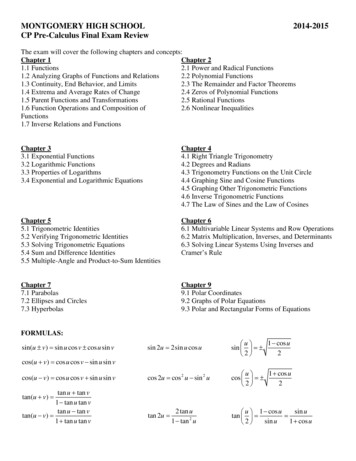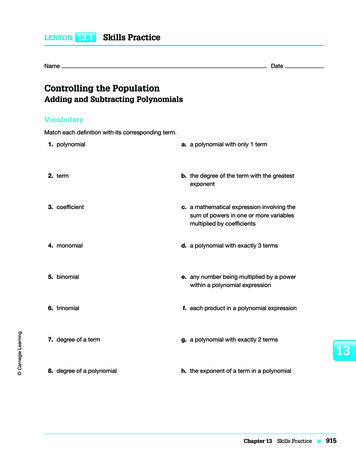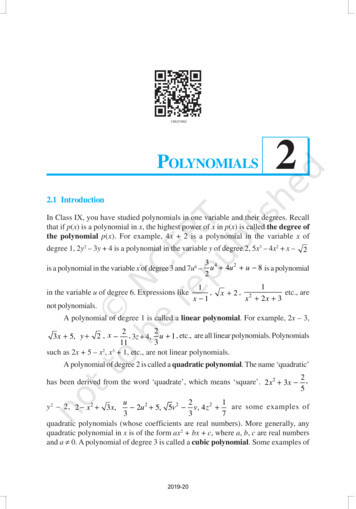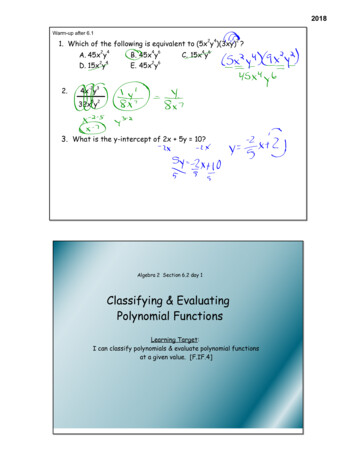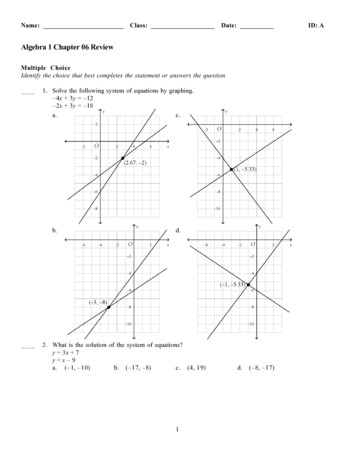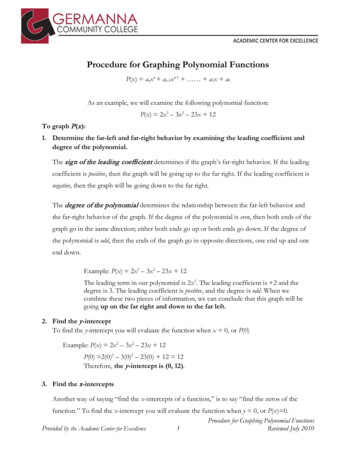
Transcription
Procedure for Graphing Polynomial FunctionsP(x) anxn an-1xn-1 a1x a0As an example, we will examine the following polynomial function:P(x) 2x3 – 3x2 – 23x 12To graph P (x ):1. Determine the far-left and far-right behavior by examining the leading coefficient anddegree of the polynomial.The sign of the leading coefficient determines if the graph’s far-right behavior. If the leadingcoefficient is positive, then the graph will be going up to the far right. If the leading coefficient isnegative, then the graph will be going down to the far right.The degree of the polynomial determines the relationship between the far-left behavior andthe far-right behavior of the graph. If the degree of the polynomial is even, then both ends of thegraph go in the same direction; either both ends go up or both ends go down. If the degree ofthe polynomial is odd, then the ends of the graph go in opposite directions, one end up and oneend down.Example: P(x) 2x3 – 3x2 – 23x 12The leading term in our polynomial is 2x3. The leading coefficient is 2 and thedegree is 3. The leading coefficient is positive, and the degree is odd. When wecombine these two pieces of information, we can conclude that this graph will begoing up on the far right and down to the far left.2. Find the y -interceptTo find the y-intercept you will evaluate the function when x 0, or P(0)Example: P(x) 2x3 – 3x2 – 23x 12P(0) 2(0)3 – 3(0)2 – 23(0) 12 12Therefore, the y -intercept is (0, 12).3. Find the x -interceptsAnother way of saying “find the x-intercepts of a function,” is to say “find the zeros of thefunction.” To find the x-intercept you will evaluate the function when y 0, or P(x) 0.Procedure for Graphing Polynomial FunctionsProvided by the Academic Center for Excellence1Reviewed July 2010
Procedure for Finding Zeros of a Polynomial Functiona) Gather general informationDetermine the degree of the polynomial (gives the most zeros possible)Example: P(x) 2x3 – 3x2 – 23x 12The degree is 3, so this polynomial will have at most 3 zeros (or 3 x-intercepts).Apply Descartes’ Rule of Signs - This rule will tell you the maximum number of positive realzeros and negative real zeros.To find the number of positive real zeros, you must count the number of sign changes inP(x). The number of positive real zeros is equal to either the number of sign changes orto the number of sign changes minus a multiple of 2.Example: P(x) 2x3 – 3x2 – 23x 12There are two sign changes in P(x), so we can conclude that there are 2 or 0(2 – 2 0) positive real zeros.To find the number of negative real zeros, you must count the number of sign changesin P(-x). The number of negative real zeros is equal to either the number of sign changesor to the number of sign changes minus a multiple of 2.Example: P(x) 2x3 – 3x2 – 23x 12P(-x) 2(-x)3 – 3(-x)2 – 23(-x) 12P(-x) -2x3 – 3x2 23x 12There is one sign change in P(-x), so we can conclude that there is one negative realzero.List possible zeros – use the Rational Zero TheoremThe Rational Zero Theorem states that to find the possible zeros of a polynomial youfind factors of the constant (p) divided by factors of the leading coefficient (q). Thesefractions will be the possible x-intercepts of the polynomial.Example: P(x) 2x3 – 3x2 – 23x 12𝑝𝑝𝑞𝑞 ��𝑓 𝑓𝑓𝑓𝑓 𝑓𝑓 𝑓𝑓𝑓𝑓 2 1, 2, 3, 4, 6, 12 1, 213 1, 2 , 2, 3, 2 , 4, 6, 12𝟏𝟏𝟑𝟑Therefore, the possible zeros of P (x ) are 𝟏𝟏, 𝟐𝟐 , 𝟐𝟐, 𝟑𝟑, 𝟐𝟐 , 𝟒𝟒, 𝟔𝟔, 𝟏𝟏𝟐𝟐.Provided by the Academic Center for Excellence2Procedure for Graphing Polynomial Functions
b) Check suspectsUse synthetic division to test the list you created above. Be aware of the Upper and Lowerbound rules; these may eliminate some of your possibilities as you discover the bounds.Upper Bound: to find the smallest positive-integer upper bound, use synthetic divisionwith 1, 2, 3, as test values. If the leading coefficient is positive, you will have theupper bound of your test values when the bottom row is all positive numbers. If theleading coefficient is negative, you will have the upper bound of the test values whenthe bottom row is all negative numbers. There will be no zeros greater than theupper bound value; therefore, no test value greater than this number will need to betested by synthetic division.Lower Bound: to find the largest negative-integer lower bound, use synthetic divisionwith -1,-2,-3, as test values. When the bottom row is alternating signs, this givesthe lower bound of the test values. There will be no zeros less than the lower boundvalue; therefore, no test value less than this number will need to be tested bysynthetic division.Example: P(x) 2x3 – 3x2 – 23x 1231Test values: 1, 2 , 2, 3, 2 , 4, 6, 12 122-32-1-23 12-1-24-24 -12-12 2-3-2-6-2312-11121122We have alternating signs in the 1/22 2-3-23121-1-12-2-240bottom row, so according to theLower Bound Theorem we will not haveany zeros less than -1.The Factor Theorem states that apolynomial P(x) has a factor (x – c) ifand only if P(c) 0.Since we have a remainder of 0, weknow that P( ½) 0. Therefore, (x– ½) is a factor of P(x).We can now create a reduced polynomial using the results from our synthetic division.P (x ) (x – ½)(2x 2 – 2x – 24)Provided by the Academic Center for Excellence3Procedure for Graphing Polynomial Functions
c) Work with reduced polynomialIf a reduced polynomial is of degree 2, find zeros by factoring or applying the quadraticformula.If a reduced polynomial is of degree 3 or greater, repeat steps a-c of finding zeros.Example: P(x) 2x3 – 3x2 – 23x 12P(x) (x – ½)(2x2 – 2x – 24)Since our reduced polynomial has a degree of 2, we can factor to get the remainingzeros.2x2 – 2x – 24(2x2 6x) (-8x – 24)2x(x 3) – 8(x 3)(2x – 8)(x 3)Factors of -48 Sum of -2 6, -8-2P(x) (x – ½)(2x – 8)(x 3)Remember: to find the x-intercepts set P(x) 0.0 (x – ½)(2x – 8)(x 3)0 x–½0 2x – 8x ½x 40 x 3x -3The x -intercepts are (½, 0), (4, 0), and (-3, 0).4. Find additional points – you can find additional points by selecting any value for x andplugging the value into the equation and then solving for yIt is most helpful to select values of x that fall in-between the zeros you found in step 3above.(x,y)xP(x) 2x3 – 3x2 – 23x 12-5P(-5) 2(-5)3 – 3(-5)2 – 23(-5) 12 -198-3/2 P(-3/2) 2(-3/2)3 – 3(-3/2)2 – 23(-3/2) 12 33(-5, -198)(-3/2, 33)-1P(-1) 2(-1)3 – 3(-1)2 – 23(-1) 12 30(-1, 30)2P(2) 2(2)3 – 3(2)2 – 23(2) 12 -30(2, -30)7/25P(7/2) 2(7/2)3 – 3(7/2)2 – 23(7/2) 12 -19½ (7/2, -19½)P(5) 2(5)3 – 3(5)2 – 23(5) 12 72Provided by the Academic Center for Excellence4(5, 72)Procedure for Graphing Polynomial Functions
5. Check for symmetry (check with respect to x-axis, y-axis, and origin)a. To check to see if a graph is symmetrical with respect to the x-axis, simply replace “y”with a “-y” and simplify. If P(x) -(P(x)) than the graph is symmetrical with respect tothe x-axis.Example: P(x) 2x3 – 3x2 – 23x 12y 2x3 – 3x2 – 23x 12-y 2x3 – 3x2 – 23x 12y -2x3 3x2 23x – 12P(x) -(P(x)); therefore, the graph is not symmetrical with respect to the x -axis.b. To check to see if a graph is symmetrical with respect to the y-axis, simply replace “x”with a “-x” and simplify. If P(x) P(-x) than the graph is symmetrical with respect tothe y-axis.Example: P(x) 2x3 – 3x2 – 23x 12P(-x) 2(-x)3 – 3(-x)2 – 23(-x) 12P(-x) -2x3 – 3x2 23x 12P(x) P(-x) therefore the graph is not symmetrical with respect to the y-axis.c. To check if a graph is symmetrical with respect to the origin, simply replace both “x”and “y” with “-x” and “-y” and simply. If the equation remains the same, then the graphis symmetrical with respect to the origin.Example: P(x) 2x3 – 3x2 – 23x 12y 2x3 – 3x2 – 23x 12-y 2(-x)3 – 3(-x)2 – 23(-x) 12y 2x3 3x2 – 23x – 12P(x) -(P(-x)); therefore, the graph is not symmetrical with respect to theorigin.Provided by the Academic Center for Excellence5Procedure for Graphing Polynomial Functions
6. Sketch the grapha. Plot the x- and y-interceptsFor our example these are: (0, 12), (½, 0), (4, 0), and (-3, 0)b. Plot the additional points you foundFor our example these are: (-5, -198), (-3/2, 33), (-1, 30), (2, -30), (7/2, -19½), (5, 72)c. Graph the curveProvided by the Academic Center for Excellence6Procedure for Graphing Polynomial Functions
If a reduced polynomial is of degree 2, find zeros by factoring or applying the quadratic formula. If a reduced polynomial is of degree 3 or greater, repeat steps a-c of finding zeros. Example: P(x) 2x3 - 3x2 - 23x 12 P(x) (x - ½)(2x2 - 2x - 24) Since our reduced polynomial has a degree of 2, we can factor to get the remaining .


